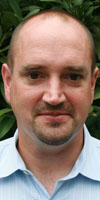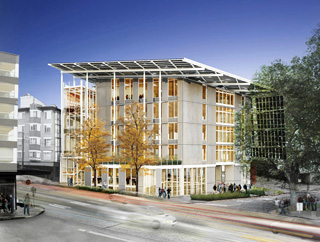|
Subscribe / Renew |
|
|
Contact Us |
|
| ► Subscribe to our Free Weekly Newsletter | |
| home | Welcome, sign in or click here to subscribe. | login |
Environment
| |
 |
February 17, 2011
2 Seattle projects set ‘net-zero’ water goals
Cascadia Green Building Council

Sisolak
|
Since 1901, Seattleites have enjoyed forest-filtered drinking water from the Cedar River watershed. Thanks to a century of protection, the Cedar delivers some of the highest-quality municipal water in the world.
Our wastewater treatment facilities also are “world class.” King County Wastewater’s $1.8 billion Brightwater plant will come online this year, adding a third mega-facility to deal with the Seattle metro area’s sewage.
So why would green building projects within the service area of both the Cedar and King County wastewater systems choose to operate off the local “water grid”? Why go through the headache of designing and permitting systems that don’t connect to the infrastructure this region pays so much to build, operate and maintain?
The Bertschi School just opened its new science classroom. Designed by the Restorative Design Collective, the new facility will capture its own rainwater, reuse graywater within the building, slow runoff with a green roof and rain garden, and boast one of the city’s first urban composting toilets.
The Cascadia Center for Sustainable Design and Construction, an office building on Capitol Hill targeted for completion in December, will also showcase composting toilets to eliminate sewage generation, rely on the rain that falls on its roof, treat graywater with a constructed wetland on its roof and manage all stormwater on site.
Both Bertschi and the Cascadia Center, a project of the sustainability-focused Bullitt Foundation, feature integrated water systems designed to be “net zero.” Analogous to net-zero energy projects that only use renewable energy for electricity, net-zero water projects combine on-site water sourcing via rainfall harvesting or groundwater, aggressive conservation, and on-site reuse and treatment to achieve near self-sufficiency from the water system.
Both the Bertschi School and Cascadia Center projects have faced scrutiny from state and regional regulators who have asked, “Why here, why now?”
Drinking rainwater
It’s true that Seattle-area residents enjoy some of the best drinking water in the world.
However, local leaders, including the city and King County, recognize that having a good supply now doesn’t guarantee a good supply forever, and that encouraging a greater diversity of systems improves the resilience of the region in the face of unknown stresses from future growth and climate change.
The city of Seattle provides permitting guidance for rainwater harvesting systems and offers rebates for water conservation efforts. King County also offers best management practice guidance for rainwater capture.
This is notable since rainwater harvesting in Washington was illegal until 2009, when the state Department of Ecology issued an interpretive policy statement clarifying that a water right is not required for rooftop rainwater harvesting. More projects that tap this great resource are sure to follow.
Another important milestone will be reached when it becomes legal in the state of Washington to use rainwater for potable uses. Recently, Public Health — Seattle & King County approved rainwater for potable use in single-family buildings as long as it is not the sole source of supply. In the city of Seattle, however, larger-scale projects permitted through the state Department of Health are still prohibited.
Both Bertschi School and the Cascadia Center will have the capacity to capture and treat rain for drinking, but for the time being they will need to also connect to the municipal supply.
Smaller wastewater systems
The case for small-scale decentralized wastewater treatment systems is easier to make and harder to sell than rainwater systems providing drinking water.
Though the facts increasingly point towards smaller decentralized systems, many communities and their utilities are already deeply invested, both financially and culturally, in large centralized systems that were conceived in another time. Today, education is needed to assure the public of the safety of modern decentralized water systems and promote their environmental, social and economic bene?ts.
Decision makers considering investments in water infrastructure also need to understand the risks hidden within the current paradigm. Large-scale water infrastructure such as Brightwater is energy intensive to build and even more energy intensive to operate.
A significant portion of energy in waste treatment systems is actually from the conveyance of waste. The further water and waste is pumped the more energy is expended. The more hills the pipes of waste climb before it reaches the treatment facility, the more energy that is used to ‘lift’ the water.
According to the Northwest Energy Efficiency Alliance, “the wastewater industry consumes … approximately 3 percent of total energy nationally and approximately 5 percent of total energy in the Paci?c Northwest.”
Cascadia Green Building Council’s own research has found that the location of a treatment facility and its associated pumping stations are major determinants of the system’s environmental footprint.
Decentralized wastewater management systems collect, treat and disperse or reuse wastewater at or near where the waste is generated. These systems may treat sewage on site through natural or mechanical processes, or collect and treat waste at a neighborhood, district or small community scale.
Smaller, more compact development patterns and shorter, gravity-fed conveyance systems have far less of an environmental impact than the conveyance needed for large sprawling developments. These systems also can be more flexible over time, allowing communities to grow their systems (or shrink them) with fluctuations in the local population size and need, and they can treat and supply water more efficiently for its intended use or reuse.
Growing concerns about building new energy-intensive infrastructure and the rising burden on taxpayers to finance these systems will surely bring smaller-scale decentralized wastewater systems to the forefront of future policy discussions.
Why here?
The city of Seattle is considered a national leader in green building, actively promotes green building best practices, and has developed policies and incentives that support integrated water system management for potable water, rainwater, stormwater and wastewater.
Similarly, King County encourages cities within the county to design and operate systems that minimize potable water consumption for non-potable uses, advocates best practices for rainwater harvesting and water reclamation, and even promotes “decentralized water management strategies to decrease energy intensity of water infrastructure.”
The county and the city realize that reduced water use means savings of energy and resources. Leaders in the design community have known this for some time, and are seeking a variety of proving grounds for employing small-scale water strategies. An urban context like Seattle, which also is a hotbed of innovation and political will, is a perfect place.
The Cascadia Center and Bertschi School projects are single examples of small-scale net-zero water projects. Alone, they won’t solve our state’s many environmental challenges or secure the city’s water future. But their designers hope they’ll chart a path that other projects in other cities both in Washington and beyond will follow.
Bertschi School and the Cascadia Center are joining a small but growing number of projects across North America that are taking on the challenge of operating off the water grid. State and local jurisdictions have an opportunity to show leadership by supporting them in this ambitious undertaking.
Joel Sisolak is the advocacy and outreach director for the Cascadia Green Building Council.
Other Stories:
- Watch out for 'greenwashing' by service providers
- EcoDistricts: Sustainability that goes beyond buildings
- Rethinking the big-box store: Housing? Restaurants? Farms?
- Public housing gets a green makeover
- Sustainable developments reach Puget Sound shores
- Green is catching on in the real estate industry
- City's role evolving as green practices take hold
- Yes, parking lots can be green
- Sustainable housing a natural fit for Bastyr
- Living Building project meant sweating the details



